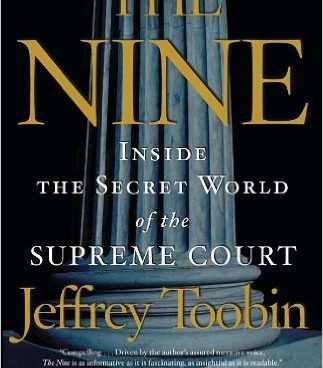Book Review: “The Nine: Inside the Secret World of the Supreme Court”

While the inner workings of the U.S. Supreme Court are largely shrouded in mystery, Jeffrey Toobin pulls back the veil in his book, “The Nine: Inside the Secret World of the Supreme Court.”
Published in 2007, “The Nine” spent four months on the New York Times bestseller list, which quite an accomplishment for a book about constitutional law. It also speaks to Jeffrey Toobin’s skill as a storyteller, seamlessly blending weighty legal analysis with juicy gossip about the justices’ personal interactions.
The Supreme Court is one of the country’s the least understood branches of government, in large part because the justices tend to limit their public comments. While Toobin relies on published decisions and other public records, his Supreme Court book is unique because he actually got inside, speaking to members of the Court on the basis of anonymity. “This book is based principally on my interviews with the justices and more than seventy-five of their law clerks,” Toobin explains in the notes. “The interviews were on a not-for-attribution basis — that is, I could use the information provided but without quoting directly or identifying the source.”
“The Nine” tracks the evolutions of the U.S. Supreme Court from 1980 to 2007, focusing on the growing influence of politics. In discussing the dynamics of the Court’s decision-making, Toobin also provides extensive portraits of the justices. For instance, he characterizes Ruth Bader Ginsburg as “a shy outsider” and Antonin Scalia as a “bitter old man.”
Toobin also details how Justice Clarence Thomas took the time to learn the names of all the police officers, cafeteria staff, and other Supreme Court workers, while Justices David Souter and Stephen Breyer were often mistaken for each other off the bench. In addition to the personality profiles, Toobin also highlights how the justices’ political leanings influenced their votes in key cases. “The Nine” particularly focuses on the role of Justice Sandra Day O’Connor as the critical swing-vote.
Toobin’s focuses in large part on how the diverse members of the Court handled controversial social issues like abortion, racial discrimination, the death penalty, and LGBT rights. It also chronicles the Court’s decision to intervene the 2000 Presidential election in Bush v. Gore. Of that case, Toobin writes: “There were times when David Souter thought of Bush v. Gore and wept.”
Finally, it is also important to note that Toobin, a lawyer, staff writer at The New Yorker, and senior legal analyst at CNN, also sprinkles in his own legal and political opinions throughout the book. For instance, he sharply criticizes Justice John Paul Stephen’s opinion in Clinton v. Jones, writing that the majority “showed a stunning naiveté about contemporary law and politics.” Yet, even if you don’t agree with Toobin’s liberal leanings, “The Nine” is still a fascinating read. It is available on Amazon.com.
